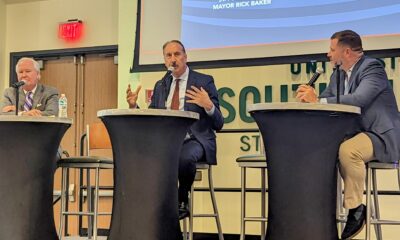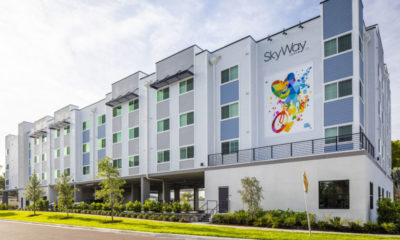Thrive
Developer Larry Feldman draws on real estate to tackle an American epidemic

Surveys showing loneliness is at a peak in the United States are shaping plans for Riverwalk Place, a luxury condominium project in downtown Tampa.
The 53-story project is being designed with restaurants, outdoor space and other amenities to bring people together, said Larry Feldman, president and CEO of Feldman Equities.
Feldman Equities and Two Roads Development in south Florida are collaborating on Riverwalk Place.
Feldman was one of four prominent local real estate experts who talked about topics ranging from office design to affordable housing at an Aug. 22 panel discussion sponsored by Bisnow, a digital media company that focuses on real estate trends.
“We’re all plugged in and wired in with a million devices and social media, so you would think people would not be lonely, but the loneliness problem is an epidemic in the United States. My job as a developer is to do things in our buildings that are going to help that,” Feldman said.
He said the Riverwalk Place project will have four restaurants, all with outdoor seating along downtown Tampa’s Riverwalk, a pedestrian trail along the Hillsborough River.
“We’re going to have as many as 240 outdoor seats and tables. We’re requiring that our restaurants that operate there be open not just for dinner. We’re requiring them to be open for lunch and in many cases breakfast. We want them all to have bar activity. We want that bar activity to be open to as late as 2 o’clock in the morning,” Feldman said.
Restaurants are one of the few types of retail that are “Amazon-proof,” despite the presence of meal delivery options such as Uber Eats, Feldman said. “They still haven’t figured out how to deliver by Amazon a night of entertainment with friends and company.”
He also wants to take advantage of the city park in front of the property.
“This will be the funnel point to enter the Riverwalk, and we think that this is a way for cities to go in the future, to create a series of entertainment zones in the heart of the city. I think it is partly an antidote to the loneliness problem,” Feldman said.
‘Generational shift’
Feldman Equities is the largest owner of office buildings in downtown St. Petersburg, where its portfolio is made up of City Center, First Central Tower and Morgan Stanley Tower downtown. The company just acquired Castille at Carillon in Carillon Office Park. Feldman also owns Park Tower and the Wells Fargo Center in downtown Tampa.
“What we’re seeing here in Tampa finally is a resurgence in the downtown. I think we’re not even in the first inning of where I think downtown Tampa can go. We’ve already seen a lot of growth in downtown St. Petersburg,” Feldman said. “What I want to see is that downtown becomes extremely dense and extremely large. I would love to see the city do away with restrictions on height and go with much greater density. I think that’s the wave of the future.”
There’s been a generational shift in how people use office space, as mobile devices bring more connectivity, said Kyle Burd, managing director of Cousins Properties, an Atlanta-based real estate investment trust that owns the Corporate Center buildings near International Plaza in Tampa, as well as Harborview Plaza and The Pointe in Rocky Point.
He cited life sciences firm Amgen (Nasdaq: AMGN), with a 136,000-square-foot capabilities center in Corporate Center I.
“They didn’t start with a design firm or an architect or engineer. They started with an organizational communications consultant. What it’s about — what Larry said — is the connectivity of the human being and the proximity from person to person in a space. Too close and you put up walls. Too far apart and you don’t connect … When they use a big conference room, people are more stiff and the communication is not as good,” Burd said. “But if we can break it down and put a cool coffee bar in the middle where the cubicles are and they cluster around there, then there’s another type of communication that goes on.”
For office landlords, that means more gyms, cafes and even shuttles from office buildings to neighborhood amenities, Burd said.
Micro housing
For apartment developers, a key challenge is attainable rents, said Nick Herring, vice president of development for Tampa-based Framework Group.
“Eighty-two percent of multi-family built in Tampa in 2018 was at ‘high level’ — about $2,000 a month — and to qualify a family has to make $80,000 a year,” Herring said. “Sixty-five percent of Hillsborough County makes less than $80,000 a year as a household. That’s 325,000 people who have effectively been left out of this latest multi-family boom.”
The opportunity to develop housing is “tremendous,” Herring said, adding, “The fact that I can’t match capital to that market opportunity means there are structural issues going on.”
One approach is to apply innovation to multi-family housing development.
“When I’m not executing one of the projects currently in our pipeline I’m thinking about how to tackle the attainable housing problem. I’m thinking about construction types, methodologies, different innovations. We’re challenging every last budget line item to see where we can pull money out of these things. We’re pushing the product type to see what will renters accept. What kind of square footage will they accept, what kind of amenities can they do away with?” Herring said.
He also called for local governments to step up.
“When there’s a market failure, a lot of times it’s government intervention that is required. By that I mean, tackling the labor issue. Let’s think about workforce development and how we get more workers here and develop more workers organically. Leverage land holdings. The city of Tampa and Hillsborough County have got fantastic pieces of land that are perfect fits for attainable housing, for workforce housing. Those should be leveraged,” Herring said. “There are also a lot of levers that cities and counties can pull. They are significant contributors to our costs in terms of fees — impact fees, permitting fees and the like. So those could be reduced when the right product is proposed.”
Feldman offered a different solution that he said would not cost local government any money.
“I would like to see Tampa become a hub for micro-units, down to 250 square feet. When you can build a unit down to that size, you can make it affordable for that 65 percent that’s being left out in the urban center,” Feldman said.
An effort to allow micro housing units in Tampa fell short a few years ago, because of city requirements for parking spaces that made a proposed project unaffordable.
Better transportation that would reduce city residents’ dependence on cars is one answer, according to David Kemper, senior principal and leader at design firm Stantec.
“Hopefully the broader solution is a shared parking scenario in the downtown environment. The Tampa Downtown Partnership has recently done a study, and the conclusion was there is enough parking. It just has to get re-allocated and shared in a better manner. I think moving forward, trying to figure that out is going to be an important part of the solution,” Kemper said.








Zalking Wombie
August 28, 2019at6:33 am
So to solve the problem of affordable housing in Tampa Bay – we’ll move people into the smaller units? How does that help families who don’t earn six figures? Also, are we saying poor people don’t need/deserve adequate living space?
I agree, there is a market failure that needs to be addressed but that market failure is people. Markets are influenced by people and real estate is driven by profit, so in the end you’ll get what makes the developer/investors the biggest return and not necessarily what benefits the community.
If I sound jaded…perhaps it’s because for the last 30 years I’ve heard the same tired ideas. Mixed used, blah blah blah. No disruption. No innovation. Same business model – different floor plate. When are we going to rise to the challenge?